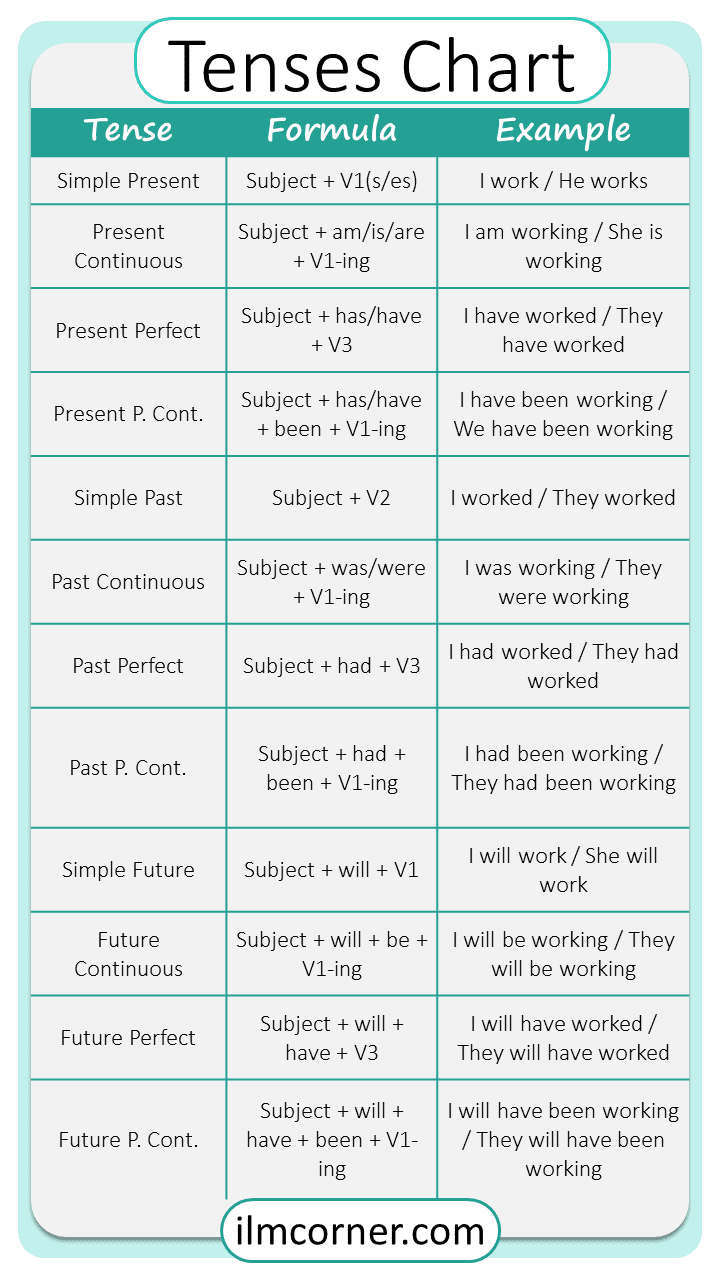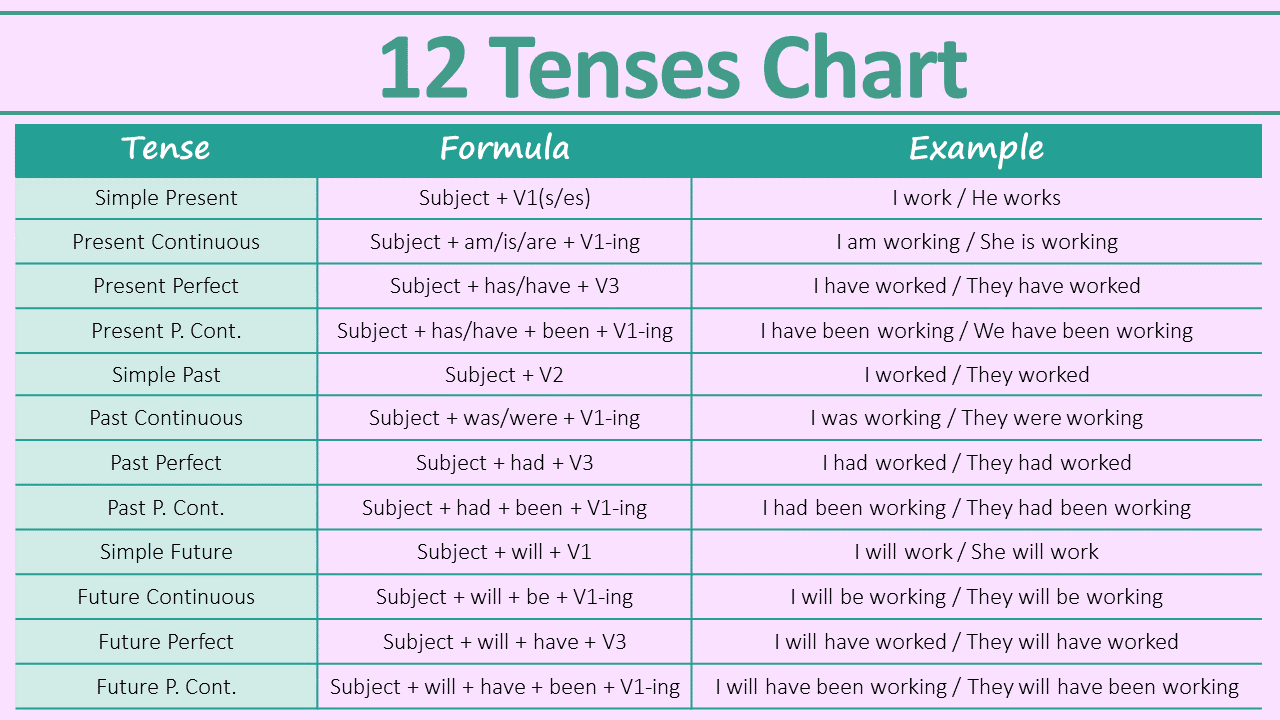Learn English tenses the easy way! Our friendly guide has a clear chart that explains each tense with simple rules, examples, and formulas. Understand past, present, and future tenses without any confusion, and start using them confidently in daily life.
Tenses Chart
| Tense | Rule | Formula | Example |
|---|---|---|---|
| Simple Present | Regular actions, habits, or facts | Subject + V1(s/es) | I work / He works |
| Present Continuous | Ongoing actions at the time of speaking | Subject + am/is/are + V1-ing | I am working / She is working |
| Present Perfect | Completed actions with a connection to present | Subject + has/have + V3 | I have worked / They have worked |
| Present P. Cont. | Ongoing actions that started in the past | Subject + has/have + been + V1-ing | I have been working / We have been working |
| Simple Past | Completed actions in the past | Subject + V2 | I worked / They worked |
| Past Continuous | Ongoing actions at a specific time in the past | Subject + was/were + V1-ing | I was working / They were working |
| Past Perfect | Actions completed before another past action | Subject + had + V3 | I had worked / They had worked |
| Past P. Cont. | Ongoing actions before a specific past time | Subject + had + been + V1-ing | I had been working / They had been working |
| Simple Future | Actions that will happen in the future | Subject + will + V1 | I will work / She will work |
| Future Continuous | Ongoing actions at a specific time in future | Subject + will + be + V1-ing | I will be working / They will be working |
| Future Perfect | Actions completed before a specific future time | Subject + will + have + V3 | I will have worked / They will have worked |
| Future P. Cont. | Ongoing actions before a specific future time | Subject + will + have + been + V1-ing | I will have been working / They will have been working |

All tenses chart in English Grammar
All Tenses used in Sentences
- Simple Present Tense Structure: Subject + V1(s/es)
Examples:
- I read a book every day.
- She watches TV in the evenings.
- He drinks coffee before work.
- They play soccer on weekends.
- We cook dinner together.
- Sarah writes emails to her colleagues.
- John walks to school every morning.
- The sun rises in the east.
- Cats like to sleep in warm places.
- He brushes his teeth twice a day.
- Simple Past Tense Structure: Subject + V2
Examples:
- I read a book yesterday.
- She watched TV last night.
- He drank coffee this morning.
- They played soccer last weekend.
- We cooked dinner together last week.
- Sarah wrote an email to her colleague.
- John walked to school yesterday morning.
- The sun set in the west last evening.
- The cat slept on the chair last night.
- He brushed his teeth before bedtime.
- Simple Future Tense Structure: Subject + will + V1
Examples:
- I will read a book tomorrow.
- She will watch TV tonight.
- He will drink coffee with breakfast.
- They will play soccer next weekend.
- We will cook dinner together next week.
- Sarah will write an email to her colleague tomorrow.
- John will walk to school tomorrow morning.
- The sun will rise in the east tomorrow.
- The cat will sleep on the chair tonight.
- He will brush his teeth before bedtime tonight.
- Present Continuous Tense Structure: Subject + am/is/are + V1-ing
Examples:
- I am reading a book right now.
- She is watching TV in the living room.
- He is drinking coffee at the café.
- They are playing soccer at the park.
- We are cooking dinner together this evening.
- Sarah is writing an email to her colleague.
- John is walking to school at the moment.
- The sun is setting in the west.
- The cat is sleeping on the chair.
- He is brushing his teeth in the bathroom.
- Past Continuous Tense Structure: Subject + was/were + V1-ing
Examples:
- I was reading a book when the phone rang.
- She was watching TV when the power went out.
- He was drinking coffee when his friend arrived.
- They were playing soccer when it started to rain.
- We were cooking dinner when the doorbell rang.
- Sarah was writing an email when her computer crashed.
- John was walking to school when he saw a dog.
- The sun was setting when we left the beach.
- The cat was sleeping when the noise woke it up.
- He was brushing his teeth when he heard a knock on the door.
- Future Continuous Tense Structure: Subject + will be + V1-ing
Examples:
- I will be reading a book when you arrive.
- She will be watching TV when you call her.
- He will be drinking coffee when we meet him.
- They will be playing soccer when we reach the park.
- We will be cooking dinner when you get home.
- Sarah will be writing an email when you visit her office.
- John will be walking to school when you pass by.
- The sun will be setting when we leave work.
- The cat will be sleeping when you come home.
- He will be brushing his teeth when you knock on his door.
- Present Perfect Tense Structure: Subject + has/have + V3
Examples:
- I have read the entire book.
- She has watched the latest episode.
- He has finished his coffee.
- They have won three soccer matches.
- We have cooked dinner for the family.
- Sarah has sent the email to her colleague.
- John has walked 5 miles today.
- The sun has set and it’s getting dark.
- The cat has eaten its food.
- He has brushed his teeth after dinner.
- Past Perfect Tense Structure: Subject + had + V3
Examples:
- I had read the book before the movie came out.
- She had watched the episode before we discussed it.
- He had finished his coffee before leaving the house.
- They had played soccer before it started raining.
- We had cooked dinner before the guests arrived.
- Sarah had written the email before the meeting.
- John had walked 5 miles before lunchtime.
- The sun had set before we reached home.
- The cat had eaten before we gave it more food.
- He had brushed his teeth before going to bed.
- Future Perfect Tense Structure: Subject + will have + V3
Examples:
- I will have read the book by the end of the week.
- She will have watched the entire series by next month.
- He will have finished his coffee before leaving.
- They will have played soccer before it gets dark.
- We will have cooked dinner before the guests arrive.
- Sarah will have written the email by tomorrow.
- John will have walked 5 miles by lunchtime.
- The sun will have set by the time we reach home.
- The cat will have eaten by the time we return.
- He will have brushed his teeth before going to bed tonight.
- Present Perfect Continuous Tense Structure: Subject + has/have + been + V1-ing
Examples:
- I have been reading this book for two hours.
- She has been watching TV since I arrived.
- He has been drinking coffee all morning.
- They have been playing soccer for an hour.
- We have been cooking dinner for the past 30 minutes.
- Sarah has been writing emails since she got to work.
- John has been walking since he left home.
- The sun has been shining all day.
- The cat has been sleeping for hours.
- He has been brushing his teeth for a while.
- Past Perfect Continuous Tense Structure: Subject + had been + V1-ing
Examples:
- I had been reading the book for an hour when she called.
- She had been watching TV when the power went out.
- He had been drinking coffee when I arrived.
- They had been playing soccer when it started to rain.
- We had been cooking dinner when the doorbell rang.
- Sarah had been writing emails when her computer froze.
- John had been walking when he found the lost wallet.
- The sun had been shining before the clouds appeared.
- The cat had been sleeping when the noise startled it.
- He had been brushing his teeth when the phone rang.
- Future Perfect Continuous Tense Structure: Subject + will have been + V1-ing
Examples:
- I will have been reading for two hours by the time you arrive.
- She will have been watching TV for an hour when you call.
- He will have been drinking coffee for a while when we meet.
- They will have been playing soccer for an hour when we join them.
- We will have been cooking dinner for 30 minutes when you get home.
- Sarah will have been writing emails for two hours by the time you see her.
- John will have been walking for an hour when you catch up with him.
- The sun will have been shining for hours by the time we go outside.
- The cat will have been sleeping for a long time when we return.
- He will have been brushing his teeth for a while when you knock on the door.
